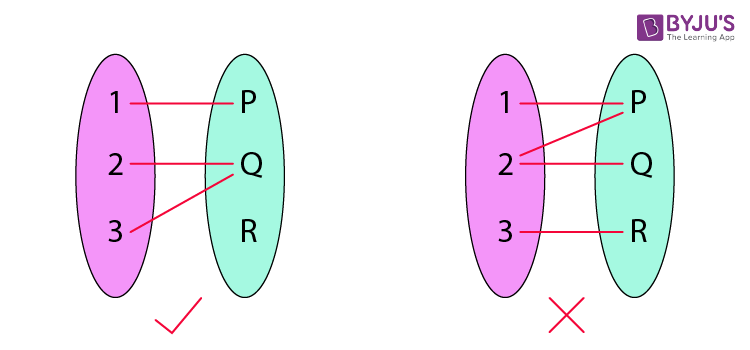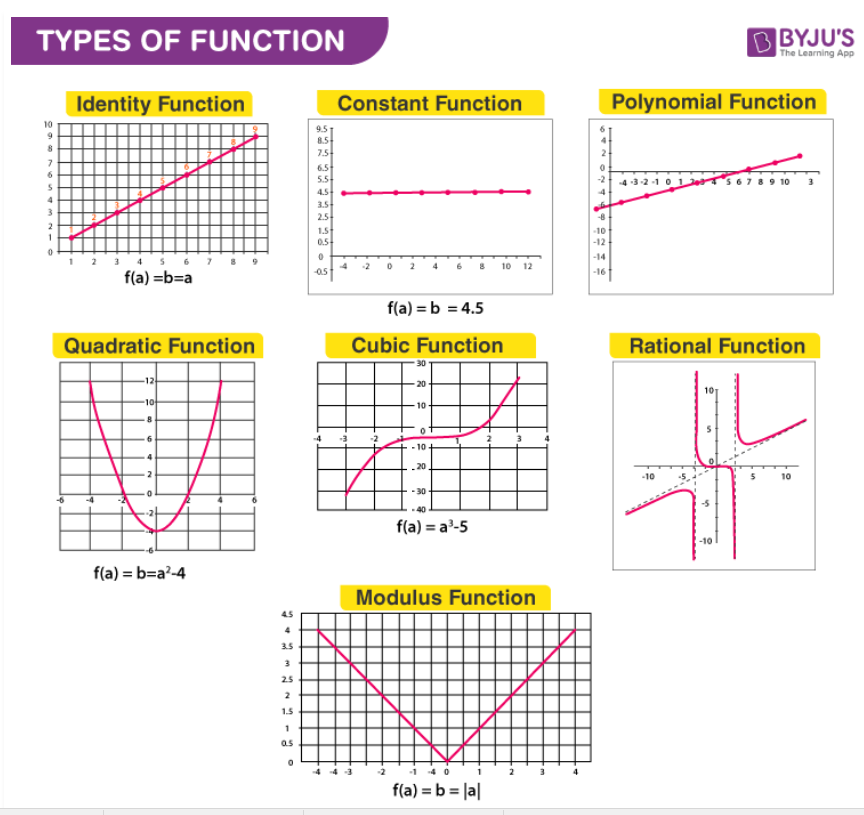Find Gof A B Discrete Mathematics Solution Exam Pdf
Functions are relations where each input has a particular output. In this lesson, the concepts of functions in mathematics and the different types of functions are covered using various examples for better understanding.
Contents Related to Functions
- Functions
- Limits, Continuity and Differentiability
- Differentiation
- Applications of Derivatives
JEE Main 2021 Maths LIVE Paper Solutions 24-Feb Shift-1 Memory-Based

What are Functions in Mathematics?
A function is a relation between a set of inputs and a set of permissible outputs with the property that each input is related to exactly one output. Let A & B be any two non-empty sets, mapping from A to B will be a function only when every element in set A has one end only one image in set B.
Example:

Another definition of functions is that it is a relation "f" in which each element of set "A" is mapped with only one element belonging to set "B". Also in a function, there can't be two pairs with the same first element.
A Condition for a Function:
Set A and Set B should be non-empty.
In a function, a particular input is given to get a particular output. So, A function f: A->B denotes that f is a function from A to B, where A is a domain and B is a co-domain.
- For an element, a, which belongs to A,
The unique element b to which f relates a, is denoted by f(a) and is called f of a, or the value of f at a, or the image of a under f.
- The range of f(image of a under f)
- It is the set of all values of f(x) taken together.
- Range of f = { y
A real-valued function has either P or any one of its subsets as its range. Further, if its domain is also either P or a subset of P, it is called a real function.
Vertical Line Test:
Vertical line test is used to determine whether a curve is a function or not. If any curve cuts a vertical line at more than one points then the curve is not a function.

Representation of Functions
Functions are generally represented as
Let ,
It is said as f of x is equal to x cube.
Functions can also be represented by g(), t(),… etc.
Steps for Solving Functions
Question: Find the output of the function
(i) t = 0
(ii) t = 2
Solution:
The given function is
(i) At t = 0,
= 5
(ii) At t = 2,
= 29
Types of Functions
There are various types of functions in mathematics which are explained below in detail. The different function types covered here are:
- One – one function (Injective function)
- Many – one function
- Onto – function (Surjective Function)
- Into – function
- Polynomial function
- Linear Function
- Identical Function
- Quadratic Function
- Rational Function
- Algebraic Functions
- Cubic Function
- Modulus Function
- Signum Function
- Greatest Integer Function
- Fractional Part Function
- Even and Odd Function
- Periodic Function
- Composite Function
- Constant Function
- Identity Function

Practice: Find the missing equations from the above graphs.
Number of Functions

One – one function (Injective function)
If each element in the domain of a function has a distinct image in the co-domain, the function is said to be one – one function.

For examples f; R R given by f(x) = 3x + 5 is one – one.
Many – one function
On the other hand, if there are at least two elements in the domain whose images are same, the function is known as many to one.

For example f : R R given by f(x) = x2 + 1 is many one.
Onto – function (Surjective Function)
A function is called an onto function if each element in the co-domain has at least one pre – image in the domain.
Into – function
If there exists at least one element in the co-domain which is not an image of any element in the domain then the function will be Into function.
(Q) Let A = {x : 1 < x < 1} = B be a mapping f : A B, find the nature of the given function (P). F(x) = |x|
 f (x) = |1|
f (x) = |1|
Solution for x = 1 & -1
Hence it is many one the Range of f(x) from [-1, 1] is
[0,1] which is not equal to co-domain. Hence it is into function. 
Lets say we have function,
For different values of Input, we have different output hence it is one – one function also it manage is equal to its co-domain hence it is onto also.
Polynomial function
A real valued function f : P → P defined by y = f (a)=
- N = a non-negative integer.
- The degree of Polynomial function is the highest power in the expression.
- If the degree is zero, it's called a constant function.
- If the degree is one, it's called a linear function. Example: b = a+1.
- Graph type: Always a straight line.
So, a polynomial function can be expressed as :
The highest power in the expression is known as the degree of the polynomial function. The different types of polynomial functions based on the degree are:
- The polynomial function is called a Constant function if the degree is zero.
- The polynomial function is called a Linear if the degree is one.
- The polynomial function is Quadratic if the degree is two.
- The polynomial function is Cubic if the degree is three.
Linear Function
All functions in the form of ax + b where a,
For example, f(x) = 2x + 1 at x = 1
f(1) = 2.1 + 1 = 3
f(1) = 3

Another example of linear function is y = x + 3

Identical Function
Two functions f and g are said to be identical if
(a) The domain of f = domain of g
(b) The range of f = the Range of g
(c)
For example f(x) = x & g(x) =
Solution: f(x) = x is defined for all x
But g(x) =
Hence it is identical for
Quadratic Function
All functions in the form of y = ax2 + bx + c where a, b,

At
In simpler terms,
A Quadratic polynomial function is a second degree polynomial and it can be expressed as;
F(x) = ax2 + bx + c, and a is not equal to zero.
Where a, b, c are constant and x is a variable.
Example, f(x) = 2x2 + x – 1 at x = 2
If x = 2, f(2) = 2.22 + 2 – 1 = 9

For Example: y = x2 + 1
Read More: Quadratic Function Formula
Rational Function
These are the real functions of the type
- For example f : P – {– 6} → P defined by f (a) =
- Graph type: Asymptotes (the curves touching the axes lines).
Algebraic Functions
A function that consists of a finite number of terms involving powers and roots of independent variable x and fundamental operations such as addition, subtraction, multiplication, and division is known as an algebraic equation.
For Example,
Cubic Function
A cubic polynomial function is a polynomial of degree three and can be expressed as;
F(x) = ax 3 + bx2 + cx + d and a is not equal to zero.

In other words, any function in the form of f(x) = ax3 + bx2 + cx + d, where a, b, c,

For example: y = x3
Domain
Range
Modulus Function
The real function f : P → P defined by f (a) =
- Domain of f = P
- Range of f =
Domain: R
Range: [0,
Signum Function
The real function f : P → P defined by
is called the signum function or sign function.(gives the sign of real number)
- Domain of f = P,
- Range of f = {1, 0, – 1}
For example: signum (100) = 1
signum (log 1) = 0
signum (x21) =1
Greatest Integer Function

The real function f : P → P defined by f (a) = [a], a
- Thus f (a) = [a] = – 1 for – 1 ⩽ a < 0
- f (a) = [a] = 0 for 0 ⩽ a < 1
- [a] = 1 for 1 ⩽ a < 2
- [a] = 2 for 2 ⩽ a < 3 and so on…
The greatest integer function always gives integral output. The Greatest integral value that has been taken by the input will be the output.
For example: [4.5] = 4
[6.99] = 6 [1.2] = 2Domain
Range
Fractional Part Function
 {x} = x – [x]
{x} = x – [x]
It always give fractional value as output.
For example:- {4.5} = 4.5 – [4.5]
= 4.5 – 4 = 0.5
{6.99} = 6.99 – [6.99]
= 6.99 – 6 = 0.99
{7} = 7 – [7] = 7 –7 = 0
Even and Odd Function
If f(x) = f(-x) then the function will be even function & f(x) = -f(-x) then the function will be odd function
Example 1:
f(x) = x2sinx
f(-x) = -x2sinx
Here, f(x) = -f(-x)
it is odd function.
Example 2:
and
f(x)=f(-x)
It is an even function.
Periodic Function
A function is said to be a periodic function if there exist a positive real numbers T such that f(u – t) = f(x) for all x ε Domain.
For example f(x) = sinx
f(x + 2π) = sin (x + 2π) = sinx fundamental
then period of sinx is 2π
Composite Function
Let A, B, C be three non-empty sets
Let f: A B & g : G C be two functions then gof : A C. This function is called composition of f and g
given g of (x) = g(f(x))
For example f(x) = x2 & g(x) = 2x
f(g(x)) = f(2x) = (2x)2 = 4x2
g(f(x)) = g(x2) = 2x2
Constant Function
The function f : P → P defined by b = f (x) = D, a
- Domain of f = P
- Range of f = {D}
- Graph type: A straight line which is parallel to the x-axis.
In simple words, the polynomial of 0th degree where f(x) = f(0) =

Identity Function
P= set of real numbers
The function f : P → P defined by b = f (a) = a for each a
- Domain of f = P
- Range of f = P
- Graph type: A straight line passing through the origin.
Functions Video
Domain, Range, Period of Functions

Functions and Relations

Find Gof A B Discrete Mathematics Solution Exam Pdf
Source: https://byjus.com/jee/functions-and-its-types/
Posted by: solistheaks.blogspot.com

0 Response to "Find Gof A B Discrete Mathematics Solution Exam Pdf"
Post a Comment